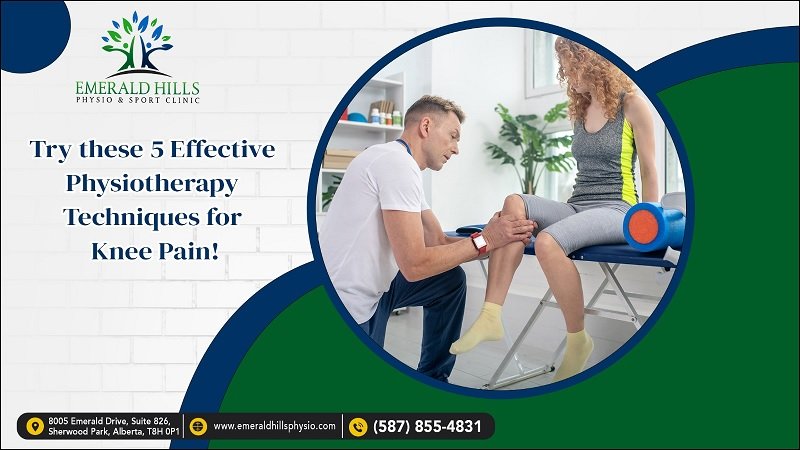Knee pain can disrupt daily activities and limit mobility, often resulting from injuries, overuse, or conditions such as arthritis. Physiotherapy Sherwood Park offers targeted treatment plans to tackle the underlying causes of knee pain. Physiotherapy helps to reduce pain, improve knee function, and restore range of motion. With the right physiotherapy approach, individuals can experience relief from discomfort and regain their ability to participate in physical activities and sustain an active lifestyle.
5 Effective Physiotherapy Techniques to Tackle Knee Pain!
Physiotherapy in Sherwood Park suggests five physiotherapy techniques designed to reduce knee pain and provide targeted relief and long-term recovery solutions.
1. Manual Therapy Techniques
Sometimes, you need a hands-on approach to alleviate knee pain. That’s where manual therapy comes in. Physiotherapists use manual therapy techniques to manipulate the knee joint, reduce stiffness, and improve circulation. This type of therapy can also help relieve muscle tension around the knee that might be contributing to pain.
Joint Mobilizations:
This involves your physiotherapist applying gentle pressure to the knee joint to increase movement and reduce stiffness. It helps with conditions like osteoarthritis, where the joint becomes particularly stiff.
Soft Tissue Mobilizations:
By massaging the muscles and tissues around the knee, this technique aims to relieve tightness and enhance blood flow to the area, speeding up recovery.
Myofascial Release:
This entails applying gentle, sustained pressure into the myofascial connective tissue restrictions around the knee. The technique helps reduce pain and restore motion by eliminating tension and tightness in the fascia that surrounds muscles and other tissues.
2. Electrotherapy and Modalities:
Physiotherapy clinic utilizes electrical energy to treat knee pain by stimulating nerves and muscles, helping to reduce pain and promote healing. Common modalities include TENS, ultrasound therapy, and shockwave therapy, each designed to target specific types of pain and inflammation for optimal recovery.
TENS (Transcutaneous Electrical Nerve Stimulation):
It utilizes low-voltage electrical currents to relieve pain. Electrotherapy can help manage knee pain by blocking pain messages before they are processed by the brain and by encouraging the production of endorphins, the body’s natural painkillers.
Ultrasound therapy:
This uses sound waves to provide deep heat to soft tissues and joints. This method is utilized to help decrease pain, inflammation, and muscle spasms around the knee. It also promotes healing by maximizing blood flow and nutrient exchange in the targeted area.
Shockwave therapy:
This non-invasive technique uses high-energy acoustic waves to stimulate healing in injured tissues and reduce pain. Shockwave therapy is particularly effective for treating conditions like patellar tendonitis (jumper’s knee), osteoarthritis, and chronic muscle strains around the knee.
3. Taping and Bracing
Taping is a highly effective physiotherapy technique for managing knee pain. Whether it’s kinesiology tape or traditional athletic tape, taping helps by providing additional support to the knee joint, reducing swelling, and improving blood flow. Similarly, knee braces can stabilize the knee, especially during movement, which can significantly reduce discomfort.
Kinesiology Taping:
The tape is applied over and around the knee in specific patterns, depending on the injury. For general knee support, the tape might form a “Y” shape around the patella or kneecap, providing lift and support to the joint. Helps in reducing inflammation, provides proprioceptive feedback to the brain to improve muscle activation, and decreases pain.
McConnell Taping:
Rigid tape is used to pull the patella medially (towards the inside of the knee), reducing pain and improving the knee’s tracking during movement. It provides instant relief from pain and helps in better alignment during activities, thus reducing the risk of further wear and tear.
Functional Braces:
To provide stability to the knee during movement, especially post-injury or post-surgery. It protects the knee from lateral movements that can exacerbate injuries, helps in the healing process, and prevents further damage.
Unloader Braces:
Specifically designed for osteoarthritis. These braces shift weight away from the affected portion of the knee, usually from the inner to the outer compartment.
4. Strengthening Exercises for the Knee Muscles
When it comes to knee pain, one of the most common culprits is weak muscles around the joint. The muscles in your legs, like the quadriceps, hamstrings, and calves, play a huge role in stabilizing the knee. Strengthening these muscles helps take the load off your knees, reducing strain and pain.
- Quadriceps Strengthening (Leg Raises): Sit or lie flat with one leg extended. Slowly lift it while keeping the leg straight. Hold for a few seconds, then lower it.
- Hamstring Curls: Stand with support. Bend your knee as far as possible, bringing your heel towards your buttocks. Lower slowly and repeat.
- Wall Sits: Recline against a wall and slide down into a sitting position as if sitting on an invisible chair. Hold for 10-15 seconds and slowly stand back up.
5. Range of Motion Exercises
These exercises are designed to keep your knee joints flexible and mobile. These exercises reduce stiffness and promote better movement, which is crucial for both recovery and prevention of further issues.
- Heel Slides: Recline on your back with your legs straight. Slowly slide one heel toward your buttocks, bending your knee, and then extend the leg back out. Repeat on the other leg.
- Knee Extensions: Rest in a chair with your feet firmly flat. Gradually straighten one leg out in front of you, hold it for a few seconds, and lower it back down.
Embracing a Pain-Free Future with Physiotherapy:
Physiotherapy in Sherwood Park offers a comprehensive approach to managing knee pain tailored to the individual needs of each patient. By tackling the root causes of knee pain and fostering the body’s natural healing processes, Emerald Hills Physiotherapy in Sherwood Park empowers patients to achieve lasting relief and a quality of life.
Whether you’re recovering from surgery, dealing with chronic conditions, or seeking to prevent future injuries, incorporating physiotherapy into your care regimen can be a pivotal step toward optimal knee health. For those seeking immediate relief, finding a skilled “physiotherapist near me” can make all the difference in accessing effective and timely treatment.
